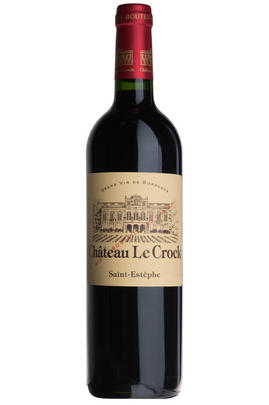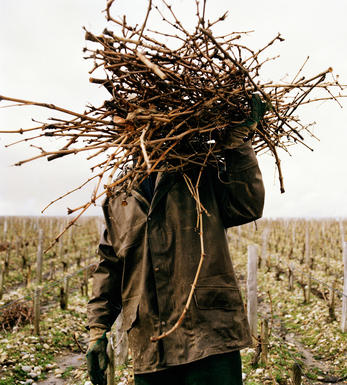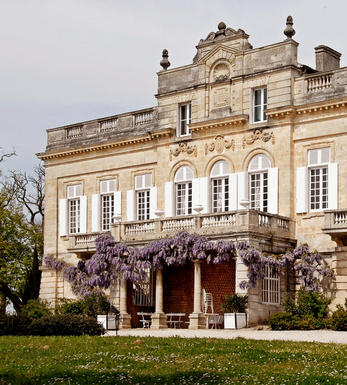
2022 Château Le Crock, St Estèphe, Bordeaux

Critics reviews
Plump fruits, this has violet edging to the inky colour, and is intense, with a tannic density that is higher than usual, and layers of cassis and chocolate block through the palate. intense and concentrated, perhaps less immediately enticing than the 2019 and 2020 vintages at Le Crock, but with clear ageing potential. Serious, structured, good appellation signature. Harvest September 12 to 26 September, 21hl/h yield.
Drink 2028 - 2040
Jane Anson, JaneAnson.com (May 2023)
The 2022 Le Crock reveals bright aromas of cherry, plum, cassis, blueberry and pencil shavings. Medium to full-bodied, concentrated and vibrant but youthfully firm, it's a blend of 47% Cabernet Sauvignon, 40% Merlot, 7% Cabernet Franc and 6% Petit Verdot. This is a strong performance from the owners of Léoville-Poyferré, now accompanied for this estate by consulting enologist Antoine Médeville.
Yohan Castaing, Wine Advocate (April 2023)
44% Cabernet Sauvignon, 40% Merlot, 11% Cabernet Franc, 5% Petit Verdot. 21 hl/ha – half the normal crop (frost/hail). Cask sample.
Firm, and structured but with a silky texture. Fragrant and floral with lift as well. Hopefully GV.
James Lawther MW, JancisRobinson.com (May 2023)
Very pretty blackberry and blackcurrant aromas and flavours. Medium body with creamy, round and juicy tannins. Will age.
James Suckling, JamesSuckling.com (April 2023)
Milk chocolate, cola, violets and ripe cherries on the nose, smells quite opulent. Juicy and so succulent, a real burst of energy and freshness but with supple and filling tannins giving joy and structure. Tannins are massy, filling and on the present side right now, but the acidity gives lift and movement to the concentrated blackcurrant and herbal raspberry fruit with lashings of liquorice, toast, cinnamon, vanilla and clove.
A lovely, very drinkable and accessible wine with clear power and succulence, body and length. Gorgeous mineral tang, too, feels well constructed with lots of detail and precision. 3.84pH. 3.84g/L total acidity. 94IPT. Harvest 12-26 September.
Drink 2026 - 2039
Georgina Hindle, Decanter.com (April 2023)
The 2022 Château Le Crock is absolutely brilliant and shows how strong the vintage is in the northern part of the Médoc. Pure black and blue fruits, graphite, lead pencil, and fresh earth all define the aromatics, and it's full-bodied, with a juicy spine of acidity and a great finish.
The 2022 is based on 44% Cabernet Sauvignon, 40% Merlot, 11% Cabernet Franc, and the rest Petit Verdot, with the harvest dates spanning the 12th to the 26th of September and tiny yields of 20.7 hectoliters per hectare. The élevage will span 14-18 months in just 30% new French oak.
For the number geeks out there, the alcohol hit 14.7% with a pH of 3.84 and an IPT of 94.
Jeb Dunnuck, JebDunnuck.com (May 2023)
About this WINE

Chateau le Crock
Château Le Crock is one of the finest Cru Bourgeois properties in St. Estèphe, and has been owned by the Cuvelier family since 1903. They also own Léoville Poyferré, as well as a successful négociant business. Le Crock is located south of the village of St. Estèphe, with its vineyards being adjacent to those of Montrose and Cos d`Estournel.
Le Crock has 33 hectares planted with Cabernet Sauvignon (60%), Merlot (25%), Cabernet Franc (10%) and Petit Verdot (5%).
Le Crock's grapes are hand-harvested and are vinified traditionally - the wine is then aged in small oak barrels (33% new) for 18 months. It is bottled unfiltered. Le Crock now property produces textbook St. Estèphes that are deeply coloured and concentrated and full-bodied on the palate. Since 1995, Michel Rolland has been a consultant and the wine has been better balanced and more harmonious.

Saint-Estèphe
Saint-Estèphe is the northernmost of the most important communes of the Médoc and borders Pauillac on its southernmost border, with only a gully and stream separates it from Ch. Lafite. To the north lies the Bas-Médoc.
Saint-Estèphe is defined by the depth of its gravel, which is ubiquitous but of varying depths and occasionally very shallow, when clay predominates. This keeps the soil cooler and wetter than its counterparts so that the wines can appear fresh in lighter vintages, but superbly successful in hot, dry years.
The best châteaux in the south of the commune have the deepest soil and the thickest gravel. Cos d'Estournel has an exceptional terroir with its vineyards being located on a south-facing ridge of gravel with excellent drainage.
Saint-Estèphe is the least gravelly of main Médoc communes and in the north of the commune the vineyards are heavier and more clay-based leading to a rustic style of wine being produced.
The wines can appear austere in youth with a discernable ferric note at some châteaux, but the best typically display good depth of colour, pronounced acidity an tannins in youth and are exceptionally long-lived. At their best, they are the equal of almost any Bordeaux. The well-regarded St Estèphe co-operative controls the production of about half the appellation.
Recommended Châteaux
Cos (Ch. Cos d'Estournel), Ch. Montrose, Ch. Calon-Ségur, Ch. Lafon-Rochet, Ch. Les Ormes de Pez, Ch. Beau-Site, Ch. Cos Labory, Ch. Phélan-Ségur

Cabernet Sauvignon Blend
Cabernet Sauvignon lends itself particularly well in blends with Merlot. This is actually the archetypal Bordeaux blend, though in different proportions in the sub-regions and sometimes topped up with Cabernet Franc, Malbec, and Petit Verdot.
In the Médoc and Graves the percentage of Cabernet Sauvignon in the blend can range from 95% (Mouton-Rothschild) to as low as 40%. It is particularly suited to the dry, warm, free- draining, gravel-rich soils and is responsible for the redolent cassis characteristics as well as the depth of colour, tannic structure and pronounced acidity of Médoc wines. However 100% Cabernet Sauvignon wines can be slightly hollow-tasting in the middle palate and Merlot with its generous, fleshy fruit flavours acts as a perfect foil by filling in this cavity.
In St-Emilion and Pomerol, the blends are Merlot dominated as Cabernet Sauvignon can struggle to ripen there - when it is included, it adds structure and body to the wine. Sassicaia is the most famous Bordeaux blend in Italy and has spawned many imitations, whereby the blend is now firmly established in the New World and particularly in California and Australia.


Buying options
Add to wishlist
Description
Blend: 44% Cabernet Sauvignon; 40% Merlot; 11% Cabernet Franc; 5% Petit Verdot.
Le Crock was affected by hail; the yield is 21hl/ha. Strongly influenced by Merlot, this has aromas of sweet blackcurrant coulis laced with bitter and sweet notes of coffee and cocoa. As always, the wine is well handled by the Ch. Léoville Poyferré team. It is polished and plush, with just enough bite and attack from the Cabernet Franc and Petit Verdot components. The solidity of St Estèphe in 2022 just creeps in a bit at the finish, but that will surely resolve itself with time in barrel and bottle.
Drink 2027 - 2040
Score: 16/20
Berry Bros. & Rudd (June 2023)
wine at a glance
Delivery and quality guarantee